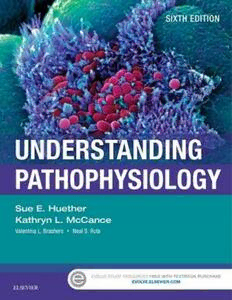
Understanding Pathophysiology by Sue E. Huether, Kathryn L. McCance PDF
Preview Understanding Pathophysiology by Sue E. Huether, Kathryn L. McCance
Understanding Pathophysiology SIXTH EDITION Sue E. Huether, MS, PhD Professor Emeritus College of Nursing University of Utah Salt Lake City, Utah Kathryn L. McCance, MS, PhD Professor Emeritus College of Nursing University of Utah Salt Lake City, Utah SECTION EDITORS Valentina L. Brashers, MD Professor of Nursing and Woodard Clinical Scholar Attending Physician in Internal Medicine University of Virginia Health System Charlottesville, Virginia Neal S. Rote, PhD Academic Vice-Chair and Director of Research Department of Obstetrics and Gynecology University Hospitals Case Medical Center William H. Weir, MD, Professor of Reproductive Biology and Pathology Case Western Reserve University School of Medicine Cleveland, Ohio With more than 1000 illustrations Table of Contents Cover image Title page Health Alerts Copyright Contributors Reviewers Preface Organization and Content: What's New in the Sixth Edition Features to Promote Learning Art Program Teaching/Learning Package Acknowledgments Introduction to Pathophysiology Part One Basic Concepts of Pathophysiology Unit 1 The Cell 1 Cellular Biology Prokaryotes and Eukaryotes Cellular Functions Structure and Function of Cellular Components Cell-to-Cell Adhesions Cellular Communication and Signal Transduction Cellular Metabolism Membrane Transport: Cellular Intake and Output Cellular Reproduction: the Cell Cycle Tissues Did You Understand? Key Terms References 2 Genes and Genetic Diseases DNA, RNA, and Proteins: Heredity at the Molecular Level Chromosomes Elements of Formal Genetics Transmission of Genetic Diseases Linkage Analysis and Gene Mapping Multifactorial Inheritance Did You Understand? Key Terms References 3 Epigenetics and Disease Epigenetic Mechanisms Epigenetics and Human Development Genomic Imprinting Long-Term and Multigenerational Persistence of Epigenetic States Induced by Stochastic and Environmental Factors Epigenetics and Cancer Future Directions Did You Understand? Key Terms References 4 Altered Cellular and Tissue Biology Cellular Adaptation Cellular Injury Manifestations of Cellular Injury: Accumulations Cellular Death Aging and Altered Cellular and Tissue Biology Somatic Death Did You Understand? Key Terms References 5 Fluids and Electrolytes, Acids and Bases Distribution of Body Fluids and Electrolytes Alterations in Water Movement Sodium, Chloride, and Water Balance Alterations in Sodium, Chloride, and Water Balance Alterations in Potassium and Other Electrolytes Acid-Base Balance Did You Understand? Key Terms References Unit 2 Mechanisms of Self-Defense 6 Innate Immunity: Inflammation and Wound Healing Human Defense Mechanisms Innate Immunity Acute and Chronic Inflammation Wound Healing Did You Understand? Key Terms References 7 Adaptive Immunity Third Line of Defense: Adaptive Immunity Antigens and Immunogens Antibodies Immune Response: Collaboration of B Cells and T Cells Cell-Mediated Immunity Did You Understand? Key Terms References 8 Infection and Defects in Mechanisms of Defense Infection Deficiencies in Immunity Hypersensitivity: Allergy, Autoimmunity, and Alloimmunity Did You Understand? Key Terms References 9 Stress and Disease Historical Background and General Concepts The Stress Response Stress, Personality, Coping, and Illness Did You Understand? Key Terms References Unit 3 Cellular Proliferation: Cancer 10 Biology of Cancer Cancer Terminology and Characteristics The Biology of Cancer Cells Clinical Manifestations of Cancer Diagnosis, Characterization, and Treatment of Cancer Did You Understand? Key Terms References 11 Cancer Epidemiology Genetics, Epigenetics, and Tissue In Utero and Early Life Conditions Environmental-Lifestyle Factors Did You Understand? In Utero and Early Life Conditions Key Terms References
